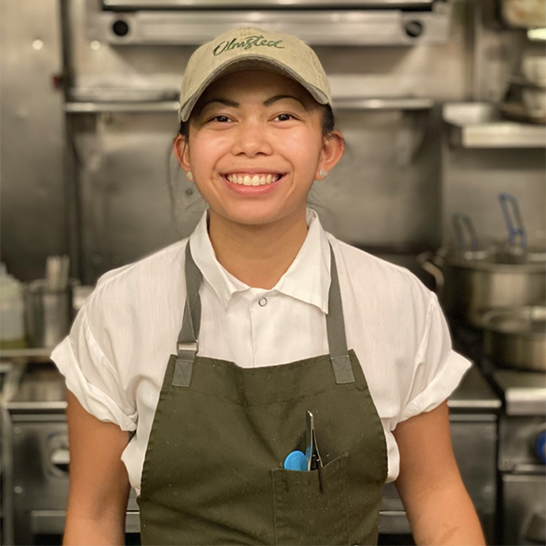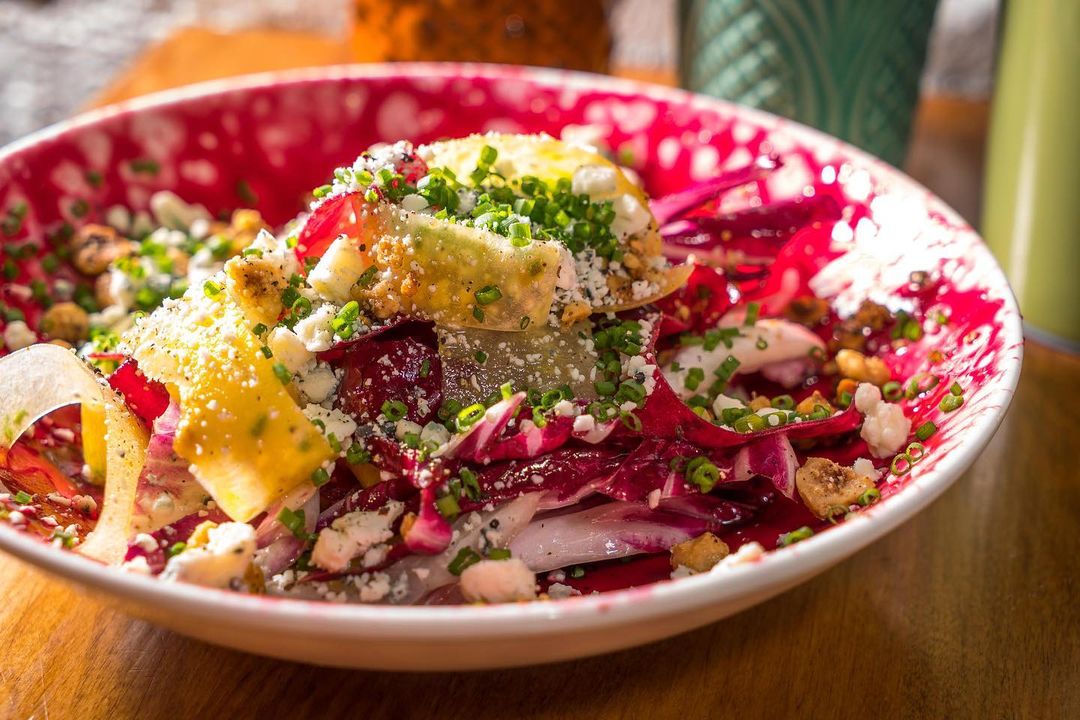
Current Position
Chef de Partie at Olmsted
Brianna Cruz Rabago
“Read. Read about every part of the industry and really dig deep into what cooking means to you and what you want to achieve.”
Should COVID-19 discourage aspiring chefs from entering the industry? Who and what are inspiring young chefs today? Chef Brianna Cruz Rabago, took a moment from her hectic schedule as Chef de Partie at Olmsted, and shared her insight.
A little about Chef Rabago: she is a 2015 C-CAP Arizona Alumnus who went on to study Culinary Arts at the Culinary Institute of America. After graduating, Chef Rabago worked at Gramercy Tavern – the beloved and Michelin starred restaurant in New York City – through the pandemic shutdown. Follow her delicious journey as a young chef in NYC on Instagram at @bricruzrabago.
What or who ignited your passion for culinary arts and when did you know you wanted to pursue this passion professionally?
I decided to pursue my passion for cooking professionally I think before I even understood my true passion for cooking. I had always felt gravitated toward cooking as a profession and looked to higher dining to experience the art, technique and culture.
You said this year allowed you to “fall in love with food at its core,” can you talk about that process and what it means to you?
When I began this career I was very green to what food was/is/will be. I worked at one of New York City’s most quintessential restaurants, Gramercy Tavern right out of culinary school and was given the best possible training for what will be the foundation of my own food philosophy.
At Gramercy Tavern we cooked the most wholesome, approachable yet progressive food with vegetables coming from the Union Square Greenmarket. We did the classics so well but understood how to change with the times – creating new classics and a new base for fine dining in New York City. When the pandemic hit and we were all laid off, the thought of not walking into that institution really hurt our team; it was disorienting not returning to the physical space but allowed us to independently find that the philosophy of food was not limited within those walls. I learned that what Gramercy Tavern has given me was the most beautiful foundation for understanding of our food system, our industry and the impending change of how those things relate.
While being laid off, I and many of my peers began to question why we were cooking and what we were cooking for. It became very evident that food and the industry have moved so far from each other. Through the beginning stages of the COVID-19 pandemic, the Black Lives Matters movement, the Election – I began to read more, think more, and ask more. I learned about what part of the food system and the industry meant to me and how that relates to the world we live in. I also viewed many perspectives of my peers and the chefs I have been mentored by. I really believe this process was a return to food. I was brought out of my dark cycle of the idea of the why I was cooking; sometimes it felt like it was beginning to be more about myself and less about the food.
The pandemic showcased how quickly our food system can collapse and how it is up to the leadership of our industry to rise up to make small ripples and big waves. Without restaurants our purveyors suffered, our farms suffered, our employees suffered, our food system suffered… But hasn’t it always been? That’s the question I ask myself everyday now. I want to continue to return to food. If I want this profession to survive, restaurants, I have to understand food at its core. I have to understand how our world has allowed us to move so far from necessity and into a luxury. I have to understand how shopping largely at the farmers market has become an ‘experience’ because we have made it largely inaccessible to most. I have to understand how this needs to move back into being a part of our lifestyle.
What Gramercy Tavern sought out was to bring that experience, which felt so far from normal because of our congestion and location and evolution as a society – but bring it to the plate. But not just to mine, to the everyday people of New York City and hopefully to our entire country. With the COVID-19 pandemic we saw that people needed food and were hungry. But that isn’t new, it has always been there. If our food system is failing it might be because we need to ask ourselves why we started cooking in the first place. Why do we as a society love food at it’s core? Because the world we live in can bear these beautiful, wholesome vegetables – grown by us that will feed us in the times of luxury but more importantly in it’s necessity. I have to ask everyone, how can we return to food?
With COVID-19, many people are discouraged from pursuing a career in culinary arts, what would you say to them?
Those looking to pursue a career in cooking right now will have to accept that the COVID-19 pandemic will vastly affect the future of food and hopefully change the landscape at which we have been accustomed to. Food has gone from a necessity to a luxury and in this luxury we can now have the conversation of what food means to us and how it impacts the world around us. Every generation of cooks and chefs before us was able to create the food world we live in today. It’s time that we accept that this industry we are a part of is changing and to be a part of it is to be of a new generation of chefs and movement. I encourage those looking to pursue their career in culinary arts to ask themselves what their true food is and how they intend to shape the world around them.
We are always curious about who young C-CAP Alums are most inspired by – can you tell us who in food is inspiring you right now? This can be chefs you admire, food magazines or columns you love, recent cookbooks you’ve dug into, etc.
Olmsted is inspiring me. This restaurant and this team has been a life changing experience. Watching the team I can call my own, during the first stages of disoriented time for the restaurant industry, I knew I wanted to be a part of this restaurant.
At the head of our team – CDC Taylor Hester and our Pastry Chef Alex Grunert have both risen above and beyond to lead us through this pandemic. With every evolution of how Olmsted will serve the community – both of these chefs have used their experience to effortlessly push our team to overcome each obstacle with grace. I am grateful to have these two chefs in my everyday life, and I encourage everyone to look around them and see if they are surrounding themselves with those types of people. If you aren’t then you have two options: become that person or find those chefs who inspire you and go work for them.
To our young readers and C-CAP high school students: looking back, what advice would you give to yourself just graduating high school, before you began at the CIA?
Read. Read about every part of the industry and really dig deep into what cooking means to you and what you want to achieve. That prospect will change as you move through the industry but there are so many opportunities to be involved in a profession that has the knowledge to change the world.
Can you share a Valentine’s / Galentine’s Day recipe for our readers, along with an image of the dish?
This dish is a classic Olmsted dish! Our shaved beet salad with Bayley Hazen Blue Cheese and candied hazelnuts. This is an exciting take on very classic flavors that I am honored to be able to share with our readers.

The beet salad is composed of sheeted and sliced red beet, golden beet, chioggia beet, daikon, and radicchio. It is dressed to order with lemon vinaigrette, salt, and black pepper.
The bowl itself is lacquered with beet paint and then the dressed salad is added. The salad is garnished with julienne preserved lemons, Bayley Hazen blue cheese crumbles, candied hazelnuts, and chives. The ratio of the salad is 2:2:1:1 Red Beet:Yellow Beet: Daikon: Chioggia. 70% Root vegetable ribbons, 30% Radicchio.
100g Salad to 30g Lemon Vinaigrette
Lemon Vinaigrette
- 400g Lemon Juice
- 200g Honey
- 30g Dijon
- 30g Salt
- 4ea Lemon Zest
- 800g Grapeseed Oil
Blend all ingredients minus oil in Vitamix. Slowly stream in oil until emulsified.
- Beet Paint
- 1000g Beet Juice
- 300g Glucose
Reduce to syrup skimming often. Pass through chinois and season with red wine vinegar and salt. Cool before use.
